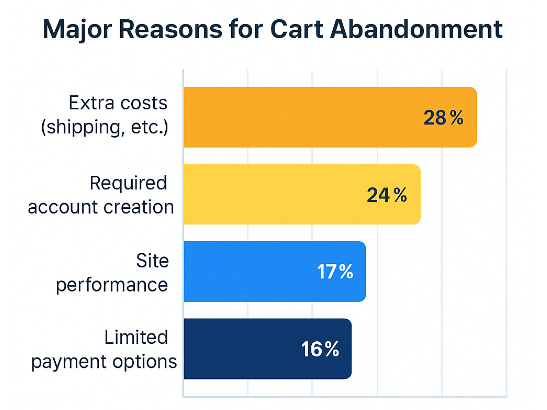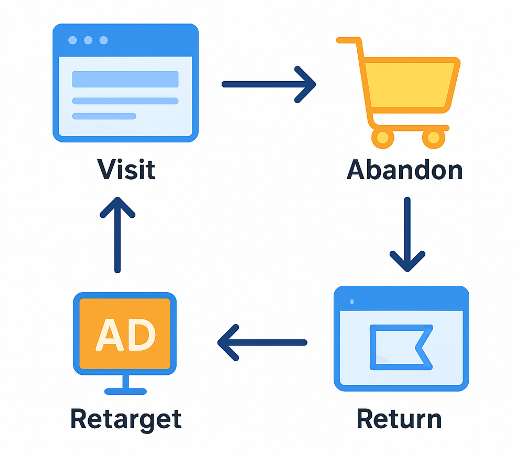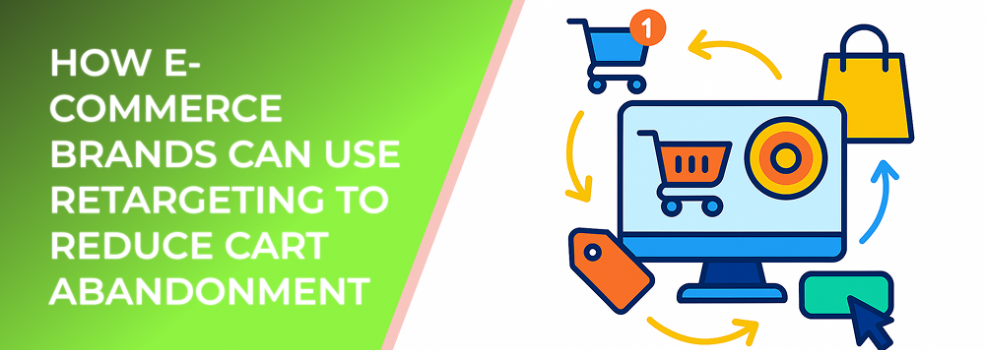According to Baymard Institute research, the average online cart abandonment rate is nearly 70%. That means seven out of ten shoppers add products to their cart but leave before completing the purchase. The reasons vary — unexpected costs, distractions, or a lack of urgency — but the result is the same: lost sales.

Primary reasons shoppers abandon carts (e.g. extra costs, forced account creation, slow page) or conversion uplift seen through retargeting
Retargeting is one of the most effective ways to bring these shoppers back. Data shows that retargeted ads can increase conversion rates by up to 150% compared to standard display campaigns.
1. Segment Your Abandoned Cart Audience
Not all abandoned carts are the same. Some users might have added high-value products, while others may be first-time browsers. Start by segmenting audiences into categories such as:
-
High-value carts (e.g., $200+)
-
First-time visitors
-
Returning customers
-
Users who viewed multiple pages

How retargeting recaptures users who visited your site but did not convert
Tailor your ad messages accordingly. For instance, a loyal customer might respond to a reminder email, while a new visitor might need a limited-time discount.
2. Use Personalized Retargeting Ads
Personalization plays a key role in retargeting success. Dynamic ads automatically show users the exact products they abandoned. Studies show that personalized product ads can deliver up to 10x higher click-through rates than generic ones.
Add a sense of urgency by including phrases like “Selling fast” or “Only a few left in stock.” Even small psychological triggers can motivate users to act quickly.
3. Time Your Retargeting Campaigns Wisely
Timing is crucial. The first 24 hours after abandonment are when users are most likely to return and buy. A good retargeting sequence might look like this:
-
0–1 hour: Send a reminder email or show a gentle ad.
-
24 hours: Offer a small incentive (like free shipping).
-
3–5 days: Follow up with a last-chance offer or testimonial ad.
Spacing your messages strategically helps maintain visibility without overwhelming the shopper.
4. Retarget Across Multiple Platforms
Don’t rely on just one channel. While Facebook and Instagram are top choices for retargeting, display ads and Google’s dynamic remarketing can catch users who browse other websites. According to Meta’s data, multi-platform retargeting increases conversion likelihood by over 30%.
Use consistent visuals, color schemes, and offers across platforms to create a seamless experience.
5. Improve Your On-Site Experience
Retargeting won’t fix a poor checkout flow. Before investing in ads, optimize your e-commerce site to reduce friction. Simplify checkout steps, offer guest checkout, and show shipping costs upfront. These small UX improvements can reduce cart abandonment by as much as 20% before retargeting even begins.
6. Combine Retargeting With Email Marketing
Retargeting works best when paired with email automation. A well-timed follow-up email reminding users of what they left behind can increase recovery rates significantly. According to Omnisend, abandoned cart emails recover about 10% of lost sales on average.
Integrate your retargeting audiences with your email platform to ensure consistent messaging and to avoid overexposure.
7. Leverage Lookalike Audiences
Once you’ve built a strong retargeting base, use it to expand your reach. Platforms like Facebook allow you to create lookalike audiences based on people who engaged with or purchased from your retargeting campaigns. This helps you attract new customers who share similar behaviors and interests.
8. Measure and Optimize Regularly
Constant optimization is key. Track metrics such as:
-
Return on Ad Spend (ROAS)
-
Cost per Acquisition (CPA)
-
Frequency and Click-Through Rate (CTR)
A/B test your creatives, incentives, and ad placements. Over time, this data-driven approach ensures higher efficiency and lower costs.
Related Articles from LeadEnforce
-
How to Analyze Campaign Data to Identify Growth Opportunities
-
How to Analyze Campaign Data to Identify Growth Opportunities
-
Q4 Campaign Planning: Setting Up Ads for Black Friday and Cyber Monday
Final Thoughts
Retargeting is one of the highest-ROI strategies in e-commerce marketing. By understanding why shoppers leave and crafting data-driven campaigns to bring them back, brands can significantly increase conversion rates. Focus on segmentation, personalization, and timing — and keep refining your approach. The shoppers who abandoned today can become your most loyal customers tomorrow.

